Menu
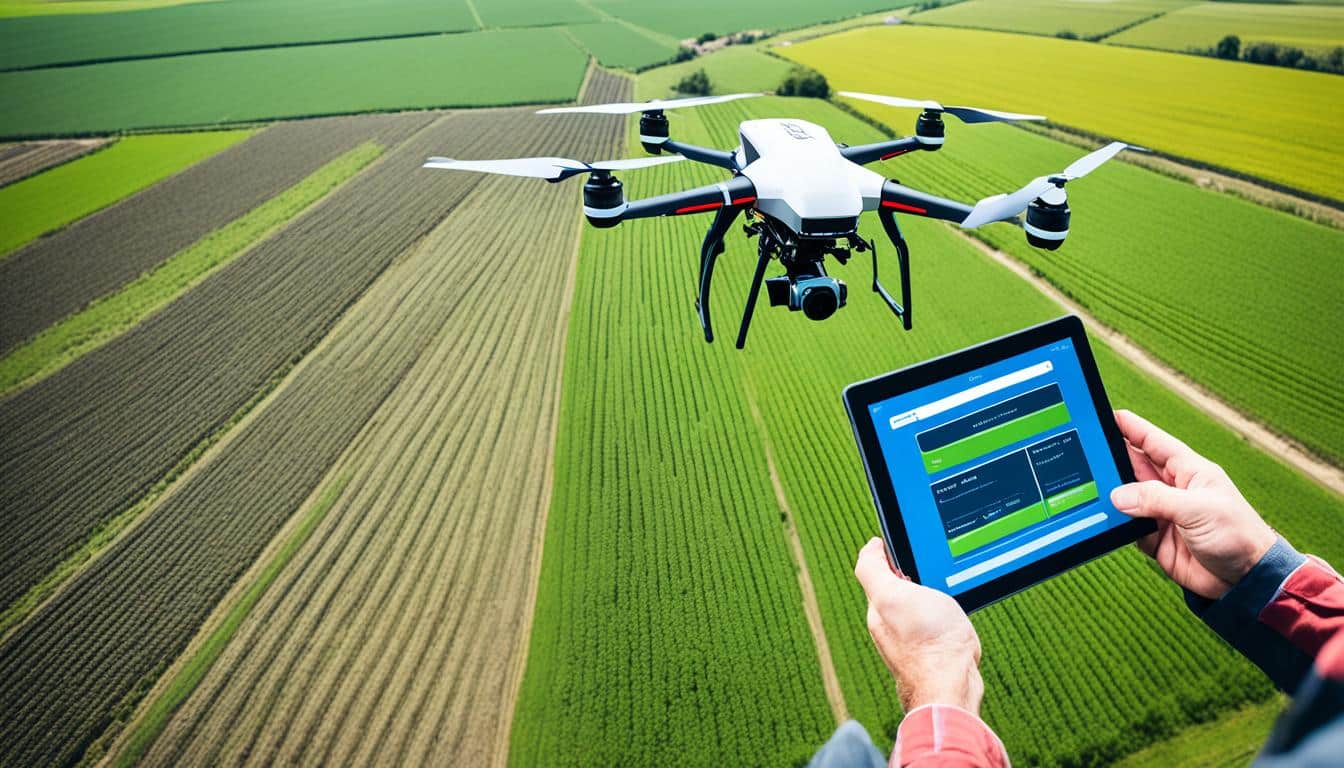
Did you know that drones can quickly identify and respond to potential security breaches? This ability can reduce risks and losses on farms. Drones give a bird’s eye view of large areas in agriculture.
This bird’s eye view helps deter theft and trespassing. Thus, drones are more cost-effective for security than traditional methods. They offer quick responses to emergencies with minimal need for extra resources.
Drones are great for all farms, big or small, increasing their safety. As we move forward, it’s clear that training in drone use is crucial for farm safety. This training lowers costs and boosts security in the farming world.
Farming with drones is changing the game. It helps tackle problems like bad weather, pests, diseases, and water use. Now, more than ever, farmers are using drones to farm smarter and greener.
Precision agriculture is on the rise. This means using cool tech to get more crops with less waste. Drones are a big help here. They fly over fields, checking the soil and crop health with super clear cameras. This info helps farmers use their land, water, and fertilisers in the best way.
“The agricultural drone market is projected to grow from $3.6 billion in 2024 to $5.7 billion by 2030.”
Drones have changed how we do things, like spraying crops. Now, it’s safer and cheaper. Drones watch the crops closely, telling the farmers where to water more or pest sprays are needed.
But drones haven’t just helped with crops. They’re also great for looking after animals and trees. In the sea, they help find schools of fish. However, not everything is easy. Some old ways of doing things and rules make using drones hard sometimes.
There’s a big need for drone pilots. This shows that working with drones is a big deal. With more farmers using drones, agriculture is stepping into the future, full of smart new ways.
| Advancements | Benefits |
|---|---|
| High-resolution Imaging | Enhanced crop monitoring, soil analysis |
| Precision Agriculture | Optimised resource use, increased crop yields |
| Sensor Technology | Efficient irrigation, real-time issue detection |
| Drone Planting | Reduced manual labour, lower machinery costs |
| Livestock Monitoring | Improved animal health and containment |
| Forestry Applications | Health monitoring, species identification |
In farming, quick action in emergencies is vital. It keeps the farm running and stops big losses. With the help of drones, farms can respond to problems fast. Drones also help cut costs and are better for the planet.
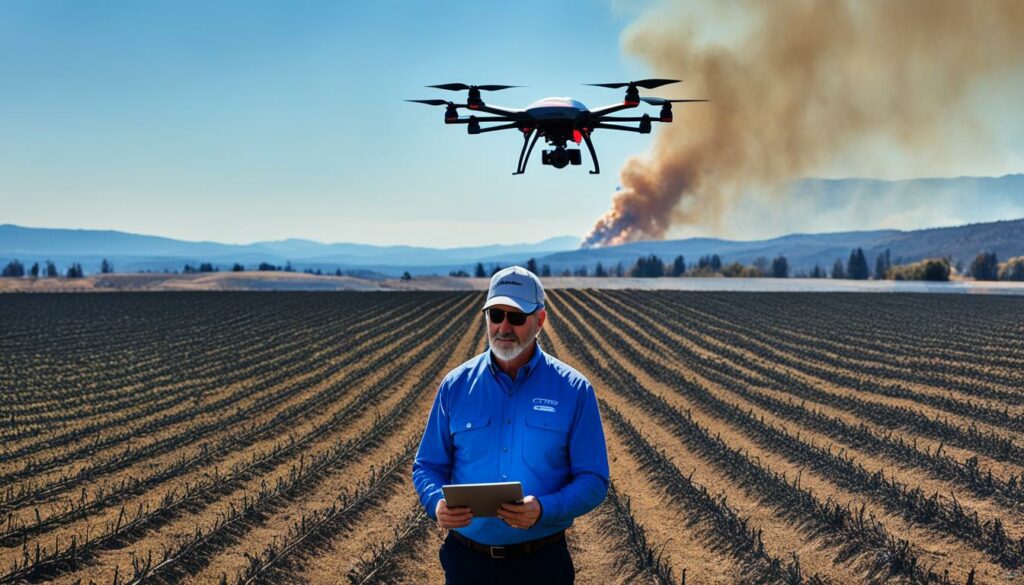
Farms face many sudden problems that need quick fixes. Things like floods, fires, and bugs can damage fields and buildings. Equipment breaking down is also a big risk.
It’s crucial to deal with these issues fast. Drones fly over the farm, giving a clear picture of what’s going on. They use cameras and special sensors to cover large areas quickly. This can save the farm’s crops and resources.
Old and new ways of farming emergency response are very different. The old methods take a lot of time and work. They use helicopters and heavy machinery that cost a lot and harm the environment.
Drones are a better choice today. According to Virgin.com, their videos are much cheaper than what helicopters take. Drones can also carry important items like first aid or communication gear. This makes them very useful in emergencies.
Using drones makes farm crisis response better. It overcomes the flaws of traditional ways. This helps make farming more eco-friendly and able to face trouble effectively.
Using drones in farming emergencies makes handling them better. They let us quickly see what needs doing. This makes our response faster and smarter.
Drones check for damage after a crisis. They give us clear pictures and data. This helps us make quick decisions about our crops.
They can also show us where our crops are not getting enough water. This helps us water them better. Drones make our farming more efficient.
Drones are also changing how we protect our crops. They can carry and spread fertilisers without the need for people in the fields. This way is cheaper and better for the environment. Some are even planting seeds, which saves even more time and money.
With more and more drones being used, the need for pilots is growing. Farms are starting to use drones for lots of jobs. This makes farming better and faster. So, we can expect to see more drones in the future of agriculture.
| Benefit | Traditional Method | Drone Solution |
|---|---|---|
| Fertilisation and Pesticide Application | Risky and Costly Crop Dusting | Safe and Cost-Effective UAVs |
| Irrigation Optimisation | Manual Inspection | Drones Identifying Water Distribution |
| Emergency Response | Slow and Resource-Intensive | Quick UAV Monitoring and Assessment |
| Planting Efficiency | Labour-Intensive | Drone Planting Experiments |
| Environmental Impact | High Chemical Usage | Reduced Chemical Usage with UAVs |
To sum up, drones are changing how we deal with farm emergencies. They’re faster and help us farm better. They are sure to play a big role in the future of farming.
Drones are changing the way we watch over farms, offering huge coverage. This is great for spotting security dangers like theft and trespassing. With drone monitoring for crop management, farmers can better protect their fields.
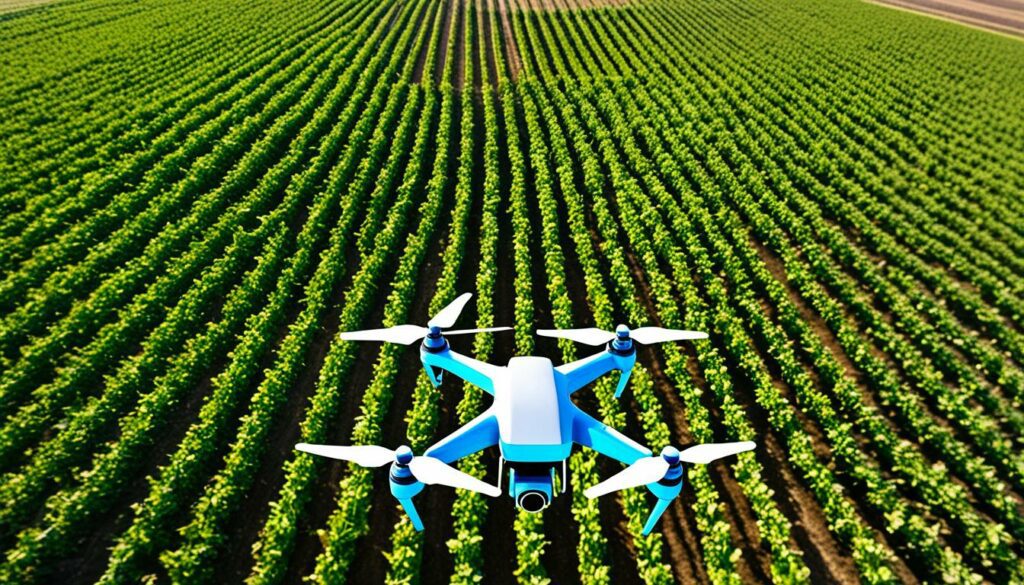
UAV surveillance is making a big difference in farming. It uses high-quality images to quickly pick up on problems. This quick response helps protect crops and property, reducing the risk of harm.
In farming, surveillance drones can save money compared to other security methods. They don’t need as much setup and are good for any farm size. They do security checks easily and don’t cost a lot to run.
Special drone training programmes make these technologies even better. They teach people how to use drones for farming effectively. This makes sure farmers get the most from drone technology.
| Advantages | Traditional Security | Drone Surveillance |
|---|---|---|
| Infrastructure | Extensive and costly | Minimal and cost-effective |
| Coverage | Limited and static | Vast and dynamic |
| Response Time | Delayed | Real-time |
| Flexibility | Rigid | Highly adaptable |
In short, drone monitoring for crop management and UAV surveillance efficiency are big assets for farm safety. Ongoing drone training ensures farms make the most of these new tools. This helps the farming industry improve its security and productivity.
Using drones in farming changes the game, making it easier to use less labour and resources. By using UAVs, big farms can cut down on the work people do and the costs of running farms in the old way.
Drones are changing the way we think about farming work. They can quickly look at large fields, meaning we need fewer people to do the job. Drones are used for many tasks, like checking plants and watching over water systems, and even spreading chemicals.
The DJI Agras T Range drone is a great example. It can spray 40 acres in just one hour, and it costs about $50,000. This is much better than using people or old machines, which saves a lot of money. You can also use cheaper drones for everyday farm jobs, saving even more.
When you think about the money side, drones are usually cheaper to keep than old farm gear. You mainly need to buy new batteries. Charging the batteries and learning how to fly drones don’t cost much either.
The DJI Mavic 3, for example, costs about $3,000 and is perfect for recording information and watching over farms. It’s a good choice for smaller farms looking to save money. There are also programs that teach how to fly drones efficiently, like the UAV Operator Certificate from the University of New Hampshire since 2017.
Using drones in farming saves money on both work and resources. It’s cheaper in the long run, too. With drones, farmers can do their work better and keep their costs low, leading to better and more profitable farms in the future.
Real-time data with drones is changing agriculture. It lets us closely watch crop health and deal with pests faster. Drones make farming tasks like monitoring crops and spraying easier, saving time and effort.
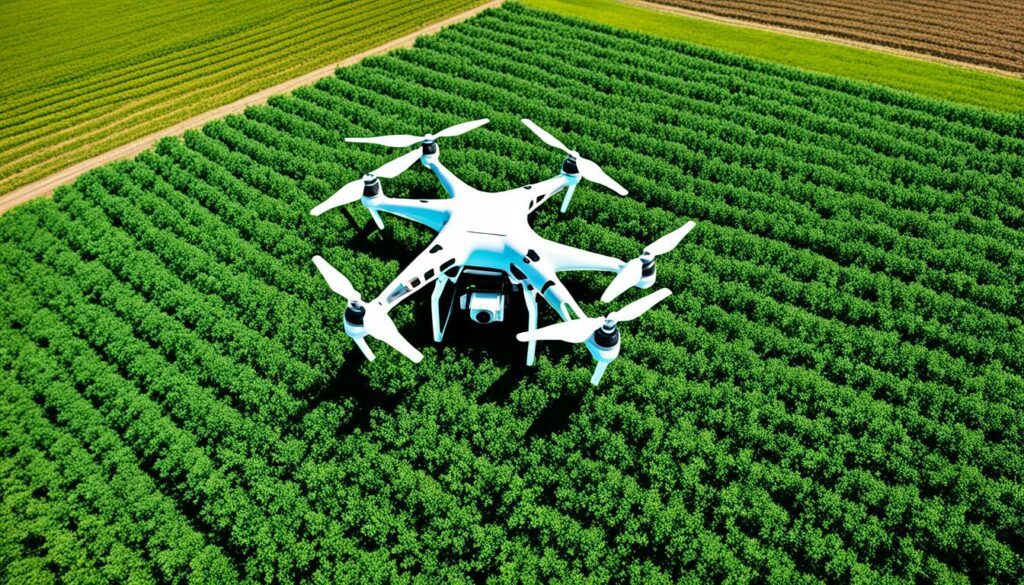
This tech is also great for the environment. Drones cut down on chemical overuse by optimising resources. They support quick, smart choices for farmers and land managers. Thanks to drone data, farmers can quickly improve how they work.
Drones are perfect for hard-to-reach places like dense forests. They’re not just for farming; drones help with flood and fire recovery too. In these situations, they give vital insights.
These flying machines with high-tech sensors predict crop yields better than before. This lets farmers adjust watering and pest control carefully. Every plant can get just what it needs.
Drones can spot when crops are in trouble early, helping to save them. They team up with smart computer programs to make sense of lots of data. This makes farming smarter and more efficient.
| Benefits of Drone Technology | Description |
|---|---|
| Precision Monitoring | Allows for accurate tracking of crop health and pest infestations, leading to enhanced crop yields |
| Automation of Tasks | Reduces exertion costs and time by automating monitoring, spraying, and mapping |
| Environmental Impact | Optimises resource use, thereby decreasing the overuse of chemicals |
| Quick Decision-Making | Enables informed decisions through real-time data collection |
| Access to Difficult Areas | Provides access to terrains that are impractical for traditional methods |
| Disaster Response | Helps in assessing damage and aiding rescue operations during disasters |
Drones and geo-tech tools bring a lot of benefits. They help predict crop yields more accurately, use resources better, and prevent crop loss. As drone tech gets better, farming with UAVs looks very promising.
Drones are changing how we manage farms by flying over even the hardest to reach places. They make it much easier to handle tasks far away or on rough terrain. This technology is a big step, making old problems like checking big areas much simpler.
These flying machines come in different types to suit various farm needs. Fixed-wing drones can fly for a long time over wide areas, thanks to their efficient design. Solar-powered drones work well in places with little support, letting farmers keep watch over fields for longer.
Drones also help keep an eye on crops, water use, and land from above in real time. When problems make satellite images hard to get, drones step in to fill the gap. This makes it easy for farmers to react quickly and in the right spot, helping to make the most of their resources.
Drones are also great at putting fertilizers and pesticides only where they’re needed, slashing waste. They’re a big help with livestock too, by tracking the animals and checking on their water without needing someone there all the time.
By using drones and all their abilities, farms can run smoother, which means more crops and less waste. This tech is a big win for a farming future that is efficient and eco-friendly.
Drones play a key role in precision agriculture. They offer amazing benefits in soil analysis and crop checks. The drone market for agriculture is set to jump from $4.17 billion in 2022 to a giant $18.22 billion by 2030.
With drones, we can look closely at the soil. This is a big change in how we care for soil health. They can check up to 500 acres a day. This is 90% faster than before, saving farmers a lot of work.
By using data from drones, farmers can cut their fertiliser use by 30%. This cuts costs and is better for the environment. Drones can spot soil problems early. This helps farmers fix issues faster and more accurately.
Monitoring crops with drones is changing the game. Drones with top-notch sensors can improve harvests by 5%. This is big news for farms trying to make more money.
Drones can find crop diseases early. This can boost harvests by 25%. Also, they help use pesticides better. For example, JOUAV drones can do the work of 14 drones at once. This makes checks more effective.
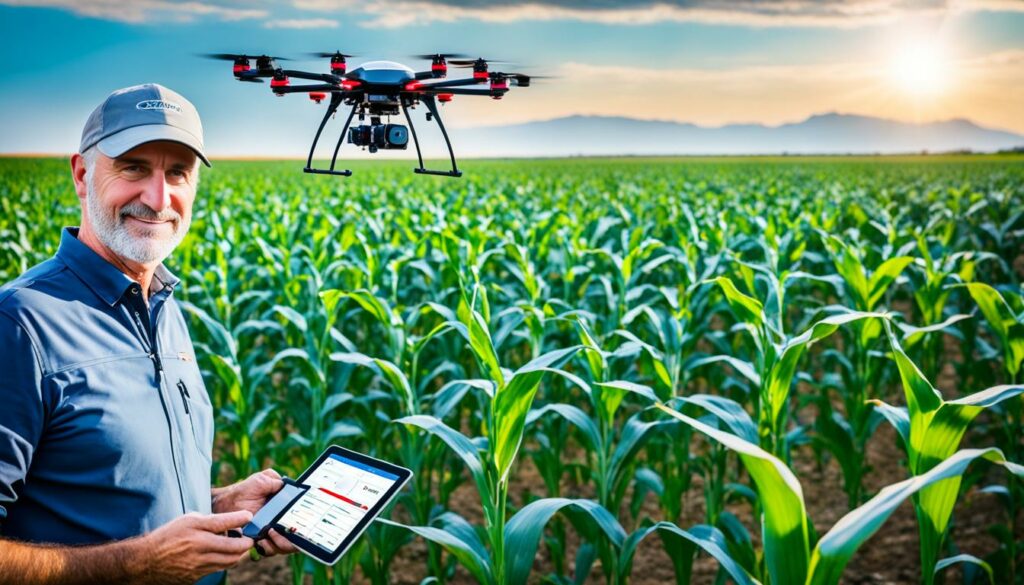
Connecting drones with farm systems improves work and cuts planning time. This makes farming more precise. It saves money and makes resources go further.
The rise of drones in farming is making the field more sustainable and effective. Drones are making a big difference in how we farm.
Drones are playing a huge part in dealing with natural disasters in agriculture. They’re very useful in many fields, especially in farming, city planning, and handling emergencies. Drones help in finding people in need during disasters and provide instant information. They can go to places that are difficult or dangerous for humans to reach. New drone technologies, like learning software and thermal imaging, make them even more effective in crises.
Natural Disasters
When natural disasters strike, drones can change the game for farming. They use advanced features to see things in real-time over large areas. This quick view helps disaster response teams act fast and in the right places. Drones are also key before disasters, as they can help predict where the most damage will happen.
Controlling pests by using drones is both effective and smart. Drones fitted with cameras can quickly find where pests are. This allows farmers to react fast and stop the pests from damaging their crops. Drones keep watching for pests even after the first treatment, so the problem can be controlled better. Their use is also a cost-saving way to collect important data for creating plans against pests.
The role of drones in managing disasters is growing. They’re essential in many ways, like spotting damage and giving out urgent supplies where people can’t easily reach. This means they’re becoming part of the solution to keep farming safer from sudden disasters.
Today, farming with drones is making a big difference for our planet. Traditional farming uses a lot of water and chemicals. This is not great for the environment. But, drones are changing this by being precise with resources.
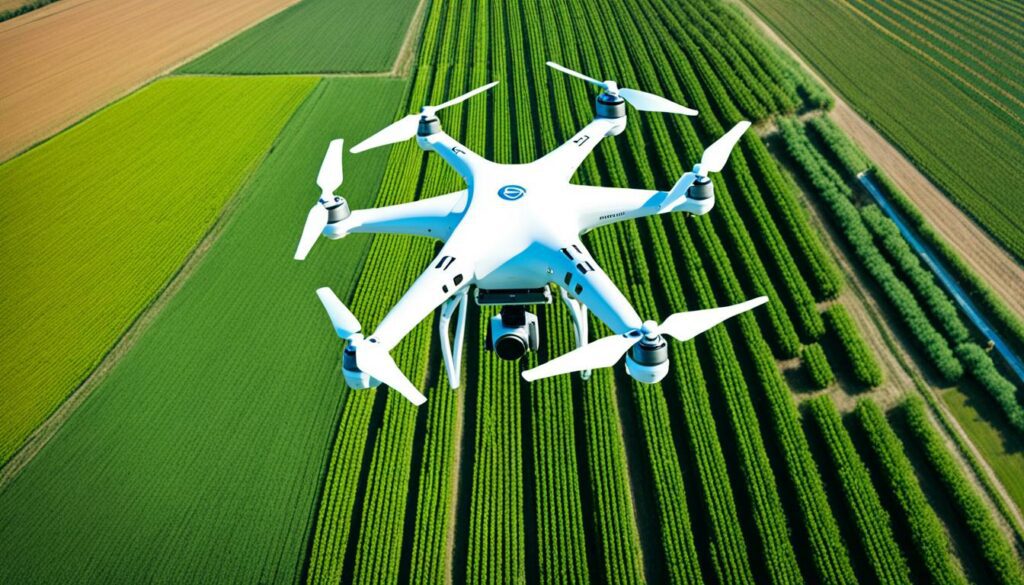
Now, drones with special sensors can map out fields. This helps with smart irrigation and fertilising. They can spot areas that need more care. This means we don’t have to use lots of chemicals everywhere. Drones are quick and can help save money. They also help reduce harm to our environment.
Drones are now doing what big planes used to. They are spraying crops with care. Not many drone companies in the U.S. can do this, but Valentine Brand can. They’re helping farms use chemicals the right way, which is good for the earth.
Drones also make looking after crops much easier. They can do in a week what used to take much longer. This cuts down on using too many resources. Drones help use water and fertiliser well, which protects our environment.
| Traditional Methods | Drone Technology |
|---|---|
| Broad-spectrum chemical use | Targeted chemical application |
| High-water usage | Optimised irrigation |
| Delayed pest management | Real-time pest monitoring |
| Manual labour dependency | Automated data collection |
In the end, using UAVs helps farming be more sustainable and kind to the planet. Drones cut down on bad environmental impacts. This way, farming can grow and be healthy for the Earth.
Agricultural drones’ future looks bright, thanks to fast-evolving UAV tech and innovative farm drone use. Currently worth $4.17 billion, the market is expected to reach $18.22 billion by 2030. This growth, at 20.3% CAGR, shows how much we rely on drone tech to boost farming efficiency.
A major plus of agricultural drones is how much ground they can cover. They handle up to 500 acres a day, beating old methods easily. This means farmers can spend more time on important jobs. Drones with top-notch cameras and sensors help make smart choices, which can lift produce by 5%.
Improving farm drones also helps our environment and economy a lot. They can cut the use of fertilisers and pesticides by pinpointing where they’re most needed. This saves money and lessens harm to the planet. Plus, spotting diseases early with drone photos can up crops by 25%, showing a big win in farm management.
A standout, like JOUAV drones, can wrap up work in a single trip that would take 14 trips for another type. These drones can fly up to 480 minutes and reach 90km/h. They showcase the potential for farmers to cut down work time and cost.
| Key Benefits | Details |
|---|---|
| Market Growth | From $4.17 billion in 2022 to $18.22 billion by 2030 |
| Acreage Coverage | Up to 500 acres per day |
| Yield Boost | Up to 5% through informed decisions |
| Cost Reduction | Reduction in fertiliser and pesticide use by up to 30% |
| Yield Increase | Early disease detection boosts yields by 25% |
| Efficiency Example | JOUAV drones cover extensive areas efficiently |
Agricultural drones are set to change farming even more in the coming years. With new farm drone ideas and full use of UAV tech, the future is exciting. This progress means farmers can count on more precise and effective ways to farm. It will drive more growth and sustainability in agriculture.
The role of drones in farming is growing, making proper training crucial. Skilled pilots can improve how farming works and follow rules better. Special training courses cover everything from basic to advanced skills. They are essential for getting certified and knowing how to use drones in farming well.
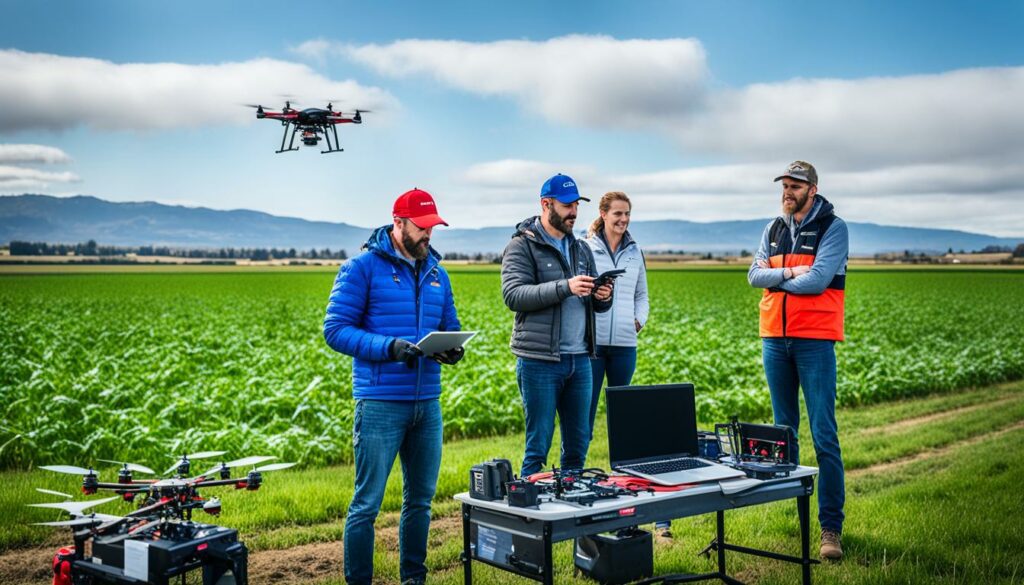
Professional development never stops for drone farmers. They take courses to stay sharp and learn about new drone tech. These courses help them work better and safer.
Flying drones in farming needs certification and rule following. A drone pilot needs the FAA Part 107 at age 16. They also need the FAA Part 137 for farming drones and may need another exemption for big drones.
To spray crops from the air, you need additional licenses depending on the state. These licenses focus on safe and effective chemical use from drones. Fair Lifts Unmanned Aerial Services helps pilots through the rules so they operate legally.
| License/Certification | Requirement |
|---|---|
| FAA Part 107 | Minimum age of 16, passing Part 107 test |
| FAA Part 137 | Required for agricultural drone operations |
| Part 137 44807 Exemption | Required for drones over 55 pounds |
| Aerial Commercial Applicator License | State-specific requirements, passing exam, practical skills demonstration |
Good training is vital for safe, efficient, and legal drone use in farming. Knowing your drone tech and the rules, plus keeping your skills sharp, matters a lot. With the right training, both farmers and drone pilots can get the most from drone technology in farming.
Drones are changing farming for the better with their precise abilities and high tech features. They make it possible to guess how much a crop will yield much more accurately. This means farmers can use things like fertilisers and water better which helps the farm make more produce and be kinder to the earth.
They also help by spotting problems with crops quickly. This early warning lets farmers act fast to save their plants. This keeps the crops healthy and leads to better harvests.
Drone tech keeps getting better. Drones are now able to fly for longer, carry bigger loads, and move more smoothly. All this shows why it’s important for farmers to use drones in their work.
Thanks to drones, farmers can get better at handling their land. They get data that shows them what needs to be done, like treating sick plants. By using drones, farmers can prevent a lot of their crops from dying, making farming smarter and better for the planet.
And drones aren’t just for farming. They are also helping in emergencies. Drones give rescue teams a bird’s-eye view, helping them save lives quicker. After disasters, they check how bad things are without risking more lives. Their value here is clear.
But, to really make the most out of drones, everyone needs to start using them more. This includes making sure they are used in the right way. Laws need to be in place to protect people’s privacy and make sure data is used the right way. If we do this, the future of farming looks greener and more efficient, with drones being a big help in everyday farm tasks and emergencies.
Drones are key in responding to emergencies on farms. They provide quick aerial views and real-time info. This helps deal fast with issues like natural disasters, theft, or pests. Their ability to cover large areas fast is crucial.
Drones give a new level of monitoring in farming. They take high-quality photos and process data immediately. This helps spot threats early, like security problems or weather changes. It’s a big step in keeping farms safe and productive.
Definitely, drones save money on labour and resources. They make jobs like surveying and monitoring easier, cutting down on manual work. Drones are also cheaper than traditional ways of spreading pesticides and fertilisers.
For sure, drones use top-notch sensors to get real-time data. This info is crucial for making smart decisions about farming. It leads to better productivity and efficiency.
Drones are a huge help in handling natural disasters and pests. They quickly assess damage, aid in rescues, and help with pest treatments. This makes farms more ready for unexpected challenges.
Using drones improves farming’s impact on the environment. They use resources like water and chemicals more effectively. By targeting problems, they reduce the need for harmful chemicals, making farming more eco-friendly.
With technology moving forward, drones are set to do even more in farming. Soon, we might have many drones working together to manage farms well. Better sensors and skills will make farming with drones even more precise and effective.
Getting trained is crucial for using drones in farming to their full potential. Courses and certification teach about the technology and rules. With the right training, farmers and pilots can make the most out of drones, boosting farm success.